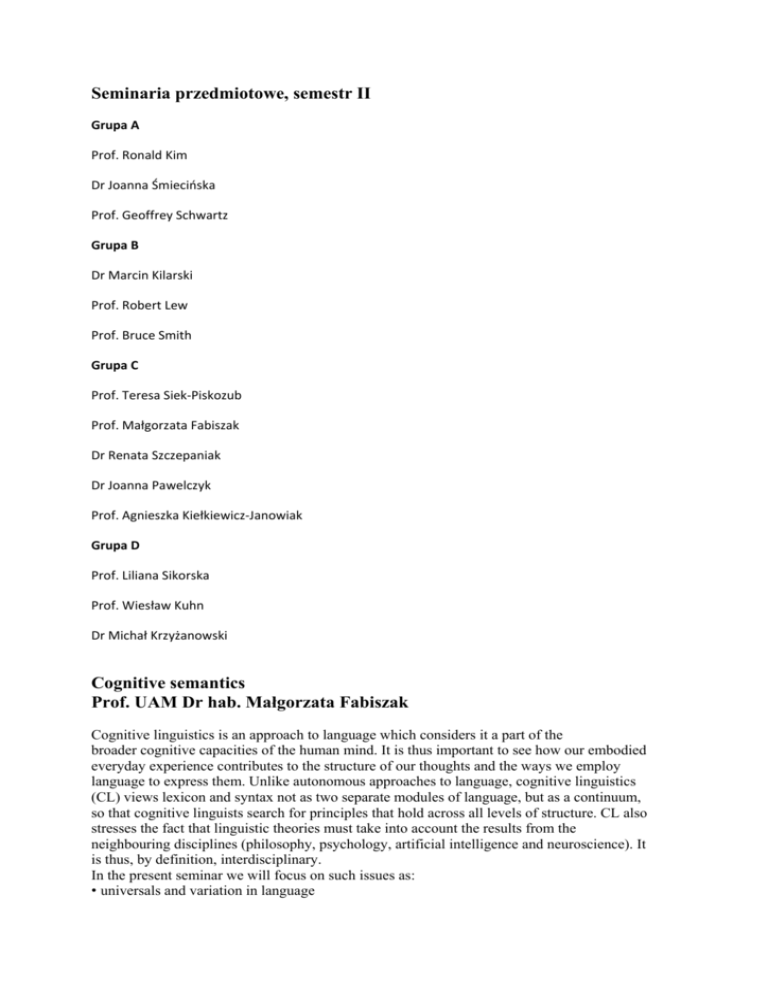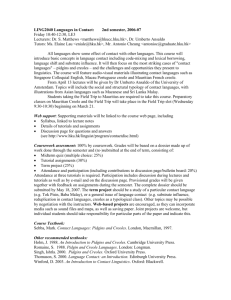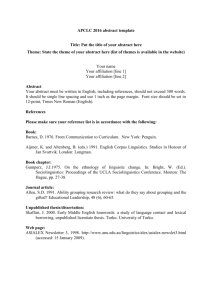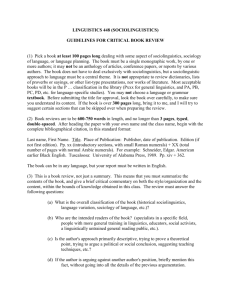Seminaria przedmiotowe, semestr II Cognitive semantics Prof. UAM
advertisement

Seminaria przedmiotowe, semestr II Grupa A Prof. Ronald Kim Dr Joanna Śmiecińska Prof. Geoffrey Schwartz Grupa B Dr Marcin Kilarski Prof. Robert Lew Prof. Bruce Smith Grupa C Prof. Teresa Siek‐Piskozub Prof. Małgorzata Fabiszak Dr Renata Szczepaniak Dr Joanna Pawelczyk Prof. Agnieszka Kiełkiewicz‐Janowiak Grupa D Prof. Liliana Sikorska Prof. Wiesław Kuhn Dr Michał Krzyżanowski Cognitive semantics Prof. UAM Dr hab. Małgorzata Fabiszak Cognitive linguistics is an approach to language which considers it a part of the broader cognitive capacities of the human mind. It is thus important to see how our embodied everyday experience contributes to the structure of our thoughts and the ways we employ language to express them. Unlike autonomous approaches to language, cognitive linguistics (CL) views lexicon and syntax not as two separate modules of language, but as a continuum, so that cognitive linguists search for principles that hold across all levels of structure. CL also stresses the fact that linguistic theories must take into account the results from the neighbouring disciplines (philosophy, psychology, artificial intelligence and neuroscience). It is thus, by definition, interdisciplinary. In the present seminar we will focus on such issues as: • universals and variation in language • language change and language acquisition • the embodiment hypothesis • encyclopaedic nature of meaning • categorization • metaphor and metonymy • polysemy • mental spaces • integration networks. Credits will be granted on the basis of 1) reading the assigned material, 2) solving in-class assignments, 3) presentation and 4) active class participation. Basic reading: Evans, Vyvan – Melanie Green. 2007. Cognitive Linguistics. An introduction. Edinburgh University Press. Geeraerts, Dirk – Hubert Cuykens. 2007. The Oxford Handbook of Cognitive Linguistics. OUP. Prof. Agnieszka Kiełkiewicz-Janowiak LIFESPAN SOCIOLINGUISTICS: focus on INTERGENERATIONAL COMMUNICATION This seminar introduces students to lifespan sociolinguistics and focuses on intergenerational communication. The latter is a case of interaction where inter-group attitudes and stereotypes give rise to tension and/or solidarity which account for communication dynamics. The following topics will be discussed: 1. Age as a sociolinguistic variable. Age-related patterns in language use. Variationist studies of discrete age populations. 2. Language, discourse and lifespan identity: Theoretical approaches to discourse and self-identity. Marking age- and generation-identity in discourse. Language socialisation across the lifespan. 3. Communication across age groups: babytalk and elderspeak; over- and underaccommodation (Coupland), communicative predicament of aging model (Giles). Intergenerational talk: its dynamics and the sources of conflict. Intergenerational solidarity. Grandchild – grandparent communication and ICT. 4. Language and ageism. Textual representations of stereotyping age groups. Societal ageism as reflected in language and discourse. Anti-ageism. Students will design a project involving data collection through semi-structured interviews with respondents representing different age cohorts. Handbook: Williams, Angie – Jon F. Nussbaum. 2001. Intergenerational communication across the life span. Mahwah, New Jersey: Lawrence Erlbaum Other readings: Barker, V. – H. Giles – J. Harwood. 2004. “Intra- and intergroup perspectives on intergenerational communication”, in J.F. Nussbaum – J. Coupland (eds.) Handbook of communication and aging research (2nd ed.) Mahwah, NJ: Erlbaum. 139-166. Cheshire, Jenny. 1987. “Age and generation-specific use of language”, in: Ulrich Ammon – Norbert Dittmar – Klaus Mattheier (eds.) Sociolinguistics: An introductory handbook of the science of language and society. Berlin: Mouton de Gruyter, 760-767. Coulmas, Florian. 2005. Sociolinguistics: The study of speakers' choices. Cambridge: Cambridge University Press. (Chapter 4. “Communicating across generations: age as a factor of linguistic choice”) Coupland, Nikolas – Justine Coupland – Howard Giles. 1991. Language, society and the elderly. Oxford: Blackwell. Coupland, Nikolas. 2001. “Age in social and sociolinguistic theory”, in: Nikolas Coupland – Srikant Sarangi – C. Candlin (eds.) Sociolinguistics and social theory. London: Pearson. 185-211. Eckert, Penelope. 1997. “Age as a sociolinguistic variable”, in: Florian Coulmas (ed.) The handbook of sociolinguistics. Oxford: Blackwell. 151-167. Harwood, J. – Giles, H. – E.B. Ryan. 1995. “Aging, communication, and intergroup theory: Social identity and intergenerational communication”, in: J. Nussbaum – J. Coupland (eds.). Handbook of communication and aging research. Hillsdale, N.J.: Erlbaum. 133-159. Harwood, Jake – Howard Giles. 1992. “‘Don't make me laugh’: Age representations in a humorous context”, Discourse and Society 3/3: 403-36. Lin, Mei-Chen – Mary Lee Hummert – Jake Harwood. 2004. “Representation of age identities in on-line discourse”, Journal of Aging Studies 18: 261–274 Nussbaum, Jon F. et al. 2005. “Ageism and ageist language across the life span: Intimate relationships and non-intimate interactions”, Journal of Social Issues 61, 2: 287-305. Nussbaum, Jon F. – Justine Coupland (eds.). 2004. Handbook of communication and aging research. (2nd edition.) Mahwah, N.J.: Erlbaum. Peccei, Jean S. 1999. “Language and age”, in: Linda Thomas – Shan Wareing (eds.) Language, society and power: An introduction. London – New York: Routledge. 99115. Williams, Angie. 2003. “Adolescents’ relationships with parents”, Journal of Language and Social Psychology 22: 58-64. Ylänne, Virpi – Angie Williams. 2009. “Positioning age: focus group discussions about older people in TV advertising”, International Journal of the Sociology of Language 2009/Issue 200: 171–187 Languages of Native North America Dr Marcin Kilarski American Indian languages are fascinating in their complexity, diversity and the ways they differ from the more familiar languages of Europe. This course is meant to be an introduction to selected aspects of their structures. As our point of departure we’ll take two morphological features typical of the languages of North America, i.e., polysynthesis and noun incorporation, as well as nominal classification, including gender and classifiers. The analysis of these morphological phenomena will then provide an insight into the syntax and lexicon of the languages. Most of the examples we'll be looking at will come from languages of the following North American Indian families: Algonquian (Ojibwa, Fox), Athabaskan (Bearlake, Chipewyan), Eskimo (Inuit, Yupik) and Iroquoian (Mohawk, Oneida, Huron, Cherokee). Why is this course relevant to your own work and interests? The languages of North America offer a unique example of the different ways in which humans conceptualize the world in linguistic structure. Some of the grammatical distinctions we’ll examine reflect common cognitive categories, while others are language-specific and reflect cultural and social patterns. The analysis of these distinctions also helps to understand the role American Indian languages have played (or failed to play) in the history of linguistics and the social sciences. On the one hand, it shows that linguistic data has to be analyzed in a pragmatic and cultural setting. On the other hand, it demonstrates the dangers of cognitive and cultural correlates of linguistic structure proposed on the basis of sloppy linguistic data. Here we’ll examine some misconceptions prevalent in the description of American Indian languages and cross-linguistic comparisons with European languages, including the supposed primitive nature of the languages and their speakers, the abundance of words for snow in Eskimo, and the so-called “Sapir-Whorf hypothesis”. Course prerequisites include successfully completed Introduction to Linguistics courses, with some background in morphology, syntax and semantics. The seminar will begin with an introduction to the language families of Native North America as well as the basic linguistic terms employed throughout the course. Prof Ronald Kim Pidgin and Creole Linguistics Few areas of linguistics have experienced such drastic expansion over the last few decades as the study of pidgin and creole languages. Since the 1960s, pidgin and creole linguistics has emerged as a legitimate field in its own right, with important contributions to sociolinguistics, historical linguistics, and linguistic theory as well as applied linguistics. Insights from pidgins and creoles have played an especially important role in the development of language contact, another rapidly growing field of linguistics. This course surveys the major findings of pidgin and creole linguistics, and introduces students to some of the major research problems in the field today. Topics to be discussed include linguistic restructuring and (degrees of) pidginization; stabilization, expansion, and creolization; pidgin and creole grammatical features; substrate transfer and universals in pidginization and creolization; the Bioprogram Hypothesis and “simplicity” argument, and their critics; the historical study of pidgins and creoles; decreolization and the post-creole continuum; and creoles in writing and as official languages of government and education. Selected bibliography: Arends, Jacques, Pieter Muysken, and Norval Smith, eds. 1995. Pidgins and Creoles: An Introduction. (Creole Language Library, Vol. 15.) Amsterdam/Philadephia: Benjamins Holm, John. 1989. Pidgins and Creoles. 2 vols. Cambridge: Cambridge University Press. Holm, John. 2000. An Introduction to Pidgins and Creoles. Cambridge University Press. Cambridge/New York: Kouwenberg, Silvia and John Victor Singler. 2008. The Handbook of Pidgin and Creole Studies. Chichester/Malden, MA: Wiley-Blackwell. Mühlhäusler, Peter. 2002. London: Battlebridge. Pidgin and Creole Linguistics. Revised and enlarged ed. Romaine, Suzanne. 1988. Pidgin and Creole Languages. London/New York: Longman. Sebba, Mark. 1997. Contact Languages: Pidgins and Creoles. New York: St. Martin’s Dr Michał Krzyżanowski Language, Discourse and the Public Sphere The aim of this course is to highlight the role of language and discourse in construction and reproduction of the public sphere(s). Following a closer theoretical discussion of theories of the public sphere and key features of political language, the course will focus on explaining and highlighting key analytic approaches to different instances of political language such as, inter alia, parliamentary and other speeches, commemorative addresses, programmatic and other documents and document-chains, interviews with politicians, political media broadcasts, etc. The first part of the course will hence be devoted to theorising and analysing differences between language-based practices specific for national and supranational politics. This part will also focus on different language- and discourse-oriented methods of analysing communication in national and supranational political milieus. Then, the second part of the course will be devoted to explaining key areas of media study from the linguistic- and discourse-analytic perspective. Following a broader theoretical introduction to the role of media in the public sphere, the course will turn to a variety of analytical approaches to different media genres in different contexts. Within the latter, a particular emphasis shall be put on the analysis of print media, broadcast media and the ‘new media’ incl. the Internet. Gothic Fictions and the American South Prof. dr Joseph Kuhn “The South” in American writing is not so much a geographical section of the United States as it is a literary idea or a region of the mind. It often appears in the writings of such Southerners as Faulkner and Poe as hardly a place at all, but rather an entity defined by absences – an entity that is lost, distant, and only incompletely mediated by memory. There is one particular genre or mode, however, that seems particularly applicable to its elusive nature. This is the Gothic, especially if the Gothic is defined in a conceptual or stylistic way as a certain blind spot or obscurity in the representation of the real. It is also the Gothic that gives partial voice to otherwise inexpressible anxieties of race and desire in the region. This seminar will try to examine a number of Southern texts that could be described as Gothic in order to try to get a clearer sense of a region that in literary terms is intangible and ghost-like. In the nineteenth century these texts will include early, quasi-symbolist works such as Poe’s “Ligeia” and regionalist short stories from the post-Civil war period such as George Washington Cable’s “Jean Ah Poquelin” and Kate Chopin’s “Desirée’s Baby”. In the twentieth century the seminar will study the modernist verse of the Nashville Fugitives such as Allen Tate’s “Ode to the Confederate Dead” and some of the fiction of William Faulkner (“A Rose for Emily”; Absalom, Absalom!). The seminar will conclude with an examination of how the Gothic forms of “the South” start to verge on a pastiche of themselves in Tennessee Williams’s drama, A Streetcar Named Desire. Studying dictionary use Robert Lew In this seminar, after a brief general introduction to lexicography we will look at a number of methods with which dictionary use can be investigated. We will examine a selection of studies of dictionary use, compare their methods and results. Students will be asked to report on and critique these studies. It is recommended that seminar participants have an active interest in details of dictionary format (themselves being keen and observant dictionary users). Credit requirements include timely reading of assignments, participation in discussion, inclass presentations, good attendance record, and design and/or administration of an original small-scale study. Dr Joanna Pawelczyk LANGUAGE AND GENDER In this seminar, we will review, discuss and critically evaluate the popular and scholarly literature on language and gender. We will begin by looking at language and gender from the perspective of dialect studies but concentrate on the language in use approach. We will start with the critical reading of one of the classics in the field i.e. Robin Lakoff's "Language and Woman's Place" (1975), representing the deficit approach to gender differences in language. We will focus however, on the most recent literature that looks at gender and language from social-constructionist perspective, in which gender is construed as performance and accomplishment in an interaction. Here we will explore how patterns of speaking perpetuate and create our experience of gender. Some of the issues we will consider include: what we mean by 'femininity' and 'masculinity' in discourse and how they are constructed and communicated in everyday conversation, the contributions language makes to situated social practice, sexuality and gendered identities in media, gender stereotypes, as well as gendered speech in social contexts. We will examine a variety of views working toward an understanding of the relationships between language and gender. Students will also develop their abilities to evaluate and critically assess material in the area of language and gender. This course requires consistent reading of the assigned texts, active participation in-class discussions as well as completion of the project. Prof. Geoffrey Schwartz Acoustics and speech perception for practical phonetics The primary goal of this seminar is to separate actual ESL speech from the symbolic representations of language. With this perspective you will be obtain improved tools to improve your (and your students') pronunciation. To achieve our goal it is necessary to become familiar with the basics of acoustic phonetics and speech analysis. You will learn how various articulations are reflected on speech spectrograms. In addition, you will become familiar with some basic issues in the study of speech perception, which is probably the single most important element underlying language learning. Note: students who have taken my 3rd year proseminar will NOT be eligible for this course Course requirements: attendance/participation 50%, two homework assignments 25%, two tests 25%. Textbook: Keith Johnson's Acoustic and auditory phonetics. Material from chapters 1, 3, and 4 may appear on homework assignments/quizzes. Prof. dr hab. Teresa Siek-Piskozub Holistic approach to teaching Research in learner factors helps to understand language learner needs. Students will get acquainted with the role of various factors stimulating holistic learner approach as evidenced by neuro-psychological research. We will discuss brain as the learning organ which can be more effectively used if properly stimulated. Brain-friendly teaching techniques will be tried out in workshops given by participants. Students will read assigned literature and prepare presentations and workshops for the seminar. They will participate in the discussion and the workshops. Course Requirements: Participation in the seminar, giving presentation on a selected topic, running a workshop, collecting all the seminar materials in a protfolio. Literature: Jensen, E. 2005. Teaching with the brain in mind. Alexandria, VA, ASCD. Siek-Piskozub, T. 1995. Gry i zabawy w nauczaniu języków obcych. Warszawa, WSiP. Siek-Piskozub, T. 2001. Uczyć się bawiąc. Strategia ludyczna na lekcji języka obcego. Warszawa, PWN Siek-Piskozub, T. 2002. Umuzykalnienie glottodydaktyki. Poznań, Motivex Siek-Piskozub, T & A. Wach 2006. Muzyka i słowa. Muzyka i piosenka na lekcji języka obcego. Poznań: Wyd. UAM. Journals • ET Forum • ELT Journal • Neofilolog • The Teacher Prof. dr hab. Liliana Sikorska The Wars we inherit: Conceptualizing violence and otherness In July 2005 there were a number of terrorists attacks in London. Soon after the attacks in one of the legitimate police actions, a Brazilian man was shot dead. He carried a “suspicious” backpack (the sign of suicide bombers) and started running away when the police stopped him to inspect his backpack. Eventually, it turned out that he tried to escape, because he was an illegal immigrant and did not have a British visa. He was killed because he had dark hair, dark skin, and could have been taken for an Arab. In a country, in which a lot of the police officers are of Indian/Pakistani and African extraction, the officers hunt the man down because he looks distrustful. The fact of the police mistake is beyond our interest but the question of racial prejudices requires further investigation. This incident clearly shows that Europe is still governed by 1500 years old fear of the monstrous races and religions. My seminar offers a study of the roots of violence and otherness in medieval and contemporary literature and culture. It is not the study of stereotypes or prejudices per se, but the study of cultural and political ideologies which generate such concepts. The classes balance theoretical issues with their illustrations in literary texts. We will begin our journey in time and space through the former British Empire in Africa, continue through Tahiti, and medieval Orient, stop by in 1970’s Britain and c1980’s Ireland, to finally arrive in the Jewel of the Crown, India. The title of the seminar is borrowed from a book by Dr Loriu Amy, a book which is coming out in April 2010 and talks about various forms of violence which influence our reading of other cultures. Dr Joanna Śmiecińska Biolinguistics The seminar will be devoted to discussing biological and evolutionary roots of language. The starting point for the discussion will be the debate between Chomsky et al. (2002, 2005) and Jackendoff (2005) concerning the (im)possibility of singling out the uniquely human feature of language. We shall review both sides’ arguments and then will try to seek the answer by covering such topics as evolution of language, language and the brain, comparison of human and animal communication, including the latest experiments with animals, differences between adult and child language, specific language disorders, Down syndrome and Williams syndrome. The knowledge gained as a result should enable the students to come up with their own opinions and answers to the problem set at the start. Requirements: one presentation with a handout, reading, attendance, active participation. Selected bibliography Hauser, Marc D., Noam Chomsky, W. Tecumseh Fitch (2002). `The Faculty of Language: What Is It, Who Has It, and How Did It Evolve?' Science 298:1569-1579 Pinker, S., & Jackendoff, R. (2005). The faculty of language: what's special about it? Cognition 95:201-236. (http://pinker.wjh.harvard.edu/articles/papers/2005_03_Pinker_Jackendoff.pdf) Fitch, W. T., Hauser, M. D., & Chomsky, N. (2005). The Evolution of the Language Faculty: Clarifications and Implications. Cognition 97(2): 179‐210. (PDF) References and selected bibliography Bernstein, N. 1967. The coordination and regulation of movements. New York: Pergamon Press. Brodman, K. 1908. "Beitrage zur histologischen Lokalisation der Grosshirnrinde: VI Die Cortexgliederung der Menschen". J. Psychol. Neurol. 10, 231-246 Calvin, W.H. and G. A. Ojemann. 1995. Conversations with Neil's brain: the neural nature of thought and language. Addison Wesley Publishing Company. http://williamcalvin.com/bk7/bk7notes.htm Glezerman, T. and V. Balkoski.1999. Language, Thought and the Brain. New York: Kluwer Academic. Enard et al. 2002 Molecular evolution of FOXP2, a gene involved in speech and language. Nature 418: 869-72. Foley, W. 1997. Anthropological Linguistics. Oxford: Blackwell. Anderson, Stephen. 2004. Doctor Dolittle’s Delusion: animals and the uniqueness of human language. Yale University Press Piaget, Jean (1926) The language and thought of the child. New York: Routledge & Kegan Paul. Prof. Bruce Smith This “Speech Science” course will include an introduction to basic acoustics, followed by a survey of a variety of topics such as speech acoustics, speech perception, speech kinematics, electromyography, electropalatography, speech technology and related topics. Methods for assessing speech production will be considered, as well as basic findings that have been obtained as result of implementing different methodologies. It is helpful if students have had an introductory course in general phonetics. Grades will be based on a combination of tests, homework, projects, class participation, and so forth. Dr Renata Szczepaniak Elements of English phraseology This seminar will examine selected aspects of English phraseology. The issues to be discussed include: the subject matter of phraseology, phraseological traditions in Europe, the typology and characteristics of phraseological units, traditional and cognitive linguistic perspectives on idioms, phraseology and culture (e.g. cultural connotations, stereotypes, symbols in phraseology), phraseological units in use (e.g. discourse functions, stylistic aspects, variation), the problems of cross-linguistic equivalence in phraseology, the treatment of phraseological units in bilingual lexicography. Credits will be given on the basis of students’ attendance, their reading of recommended literature and active participation in seminar discussions, a 20-minute presentation and a final test.








